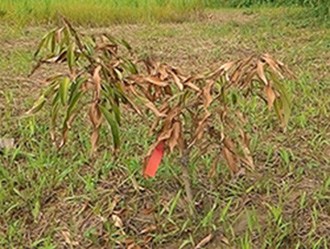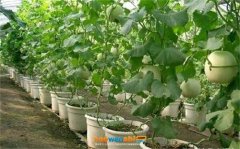What are the manifestations of water-deficient leaves of plants? Introduction to the characteristics of leaves of over-wet plant soil
Leaf characterization of water deficiency and excessive wetness in plants. The root of the plant is healthy but the soil moisture is insufficient, and the leaves have non-stop evapotranspiration water consumption, especially in autumn when there is no rain, strong wind and hot sun, this situation is most likely to happen to newly planted seedlings, especially in autumn, it is safest to water newly planted seedlings at least once a day. There are three main leaf characteristics of water deficiency in plants:
1. Tender shoots, leaves and peduncles are sagging. Such as Borromi, star apple, passion fruit, kiwi fruit, pear, etc., as long as the plant does not reach the permanent withering point, it is found that the situation will be watered immediately, and usually the sagging part will harden again after 2-3 hours. This kind of sagging branches and leaves caused by lack of water is very easy to identify.
2. The leaves are yellow and crisp. Such as lotus fog, litchi, rambutan, blue flower, etc., when there is no water shortage, the branches and leaves do not sag, the leaf stalks are always stiff, and the leaves quickly turn to dry coke within a few hours. this is caused by lack of water plus strong sun, high temperature or dry strong wind. It is found that although watering immediately can not restore the appearance of the leaves, as long as the permanent withering point is not reached, the new buds germinate and the old leaves continue to grow. # the following four cases have one thing in common, that is, the leaves are stiff and dry from the bottom up, which means that the healthy physiological cycle of the roots of the seedlings is normal (no rotten roots, no drooping leaves), and the withered leaves are caused by rapid air drying under the condition of lack of water. Please look at this picture of the blue flower, the terminal bud is still green, the lower leaves are all withered, and the withered leaves remain stiff.
3. The tender leaves atrophied, but the shoots did not sag. Plum, apricot, apricot, cherry, peach, plum and other Rosaceae trees, lack of water until the young leaves appear wrinkled, even if it is too late to water immediately, the branches are still full and stiff, but after a day or two, the branches appear longitudinal shrinkage lines and gradually spread down. as far as grafted seedlings are concerned, only the branches of the young leaves withered, the most serious ones even withered along with the rootstock. Therefore, the initial planting of Rosaceae trees must beware of water shortage (at least once a day). At the initial stage of this kind of water shortage, the leaves are not characterized, and they can be irrigated immediately, but if the water shortage reaches the critical point (tender leaves atrophy), it often dries down gradually and finally the whole plant dies. So you can't be careful.
[over-wet]
It is not too wet to say that the seedling potted soil or soil is often wet, but the water is so much that the rotting roots are too wet, and the unhealthy leaves of the roots must be characterized by the so-called red roots, and the strong leaves of the roots must be stiff and shiny. Rotten roots make the plant appear "regular" floppy branches, dull leaves and soft paralysis. Figure 1 below shows the situation of rotten roots, and figure 2 shows the comparison of leaf characteristics between robust roots (left) and rotten roots (right).
Note:
1. What is the difference between the sagging of branches caused by excessive dampness and the lack of water (item 1 above)?
The soft sag caused by lack of water will recover after a few hours of watering, which is temporary, and the soft sag caused by too wet and rotten roots can not be watered.
Reply, the top of the branch shows the phenomenon of regular sagging.
2. Will the leaves of seedlings with rotten roots be scorched and crisp (item 2 above) when they are exposed to the scorching sun for a long time?
As long as the rotten root is not dead, although the leaves are still green after the scorching sun for a long time, but the leaves are light green or yellowish, and there is no light in the leaves and soft paralysis in texture.

- Prev

The price of fruit has risen seriously. why is the price of fruit rising? what is the futures price of apple and red jujube?
Have you found that the price of fruit this year is higher than that of previous years, especially the current price of red jujube? why? Since mid-May 2019, the price of fruit has generally risen in both the investment market and the retail market.
- Next

Melon planting techniques and management knowledge, detailed explanation of muskmelon soilless cultivation techniques
The main producing areas of our country are Xinjiang, Gansu and other northwest regions. In recent years, the southeast planting of muskmelon has been explored in the eastern and southern provinces of China, such as Guangdong, Guangxi, Hainan, Shanghai, Fujian, Zhejiang, Nanjing and so on.
Related
- A one-day flower show brings 130 million yuan in orders! Nanhai, this Phalaenopsis exhibition is amazing
- What do the flower language and meaning of Lutheran tree mean? Precautions for planting Lutheran tree
- Encounter Chaoshan Kongfu tea, not without this cup of Phoenix single clump
- The durian market in Vietnam and Thailand is flooded. The price of imported durian has plummeted by 30-40% in a month.
- Shanghai solved the problem of local vegetable supply by planting 80,000 mu of green leafy vegetables.
- Wageningen University has become the best agricultural university in the world for the seventh time in a row.
- The strongest export season of South African grapes is full of challenges, with exports to Russia falling sharply by 21%.
- Sri Lanka is on the verge of bankruptcy, "Tea for debt" Organic Agriculture Revolution aggravates the Food crisis?
- Turning waste into earthworm manure and worm manure into organic fertilizer-A new choice for auxiliary farming
- Organic rice growers shoulder the responsibility of nurturing agricultural talents! Yinchuan Sustainable Farm with Organic Life Camp

